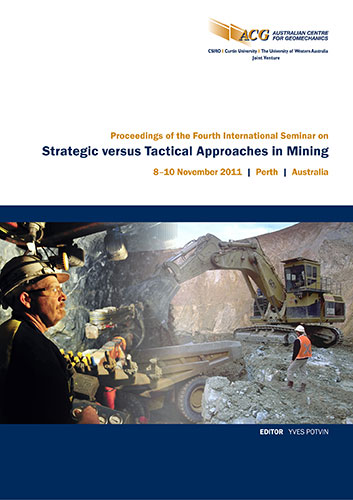Strategic management for squeezing ground conditions at the Argyle Diamonds block cave project

|
Authors: Fernandez, F; Watt, G; Ooi, J |
DOI https://doi.org/10.36487/ACG_rep/1108_06_Fernandez
Cite As:
Fernandez, F, Watt, G & Ooi, J 2011, 'Strategic management for squeezing ground conditions at the Argyle Diamonds block cave project', in Y Potvin (ed.), Strategic versus Tactical 2011: Proceedings of the Fourth International Seminar on Strategic versus Tactical Approaches in Mining, Australian Centre for Geomechanics, Perth, pp. 55-72, https://doi.org/10.36487/ACG_rep/1108_06_Fernandez
Abstract:
A methodology of damage assessment has been elaborated, based on conditions encountered in the Argyle Diamonds Underground Project (ADUP). It has been developed iteratively over a number of months and has been used to comprehensively represent damage conditions as the undercut front advances. Correlation between damage and convergence has been established. The ground support regime that has been implemented at the ADUP to withstand very severe squeezing (Hoek and Marinos, 2000) has produced the outcome that only in limited areas of extreme squeezing (in excess of 20% convergence) has stripping and rehabilitation been required to enable undercutting operations to continue. This issue highlights the importance of the implementation of adequate guidelines to maintain drive stability and safety during undercutting. The long-term and strategic implications of correlating damage conditions with convergence and therefore deformation are that a practical predictive model can be developed. This can then be used to forecast the level of damage that is likely to occur in the undercut drives and extraction level drives based on displacement modelling. This model allows an optimised level of support and reinforcement to be designed depending on the predicted damage conditions. Such a ‘predictive’ model could be used to estimate the optimal level of support and reinforcing (and to establish a realistic budget and schedule for the work); as well as an ongoing tool for forecasting damage conditions (and remedial support and reinforcing) during undercutting and block caving progression.
References:
Brown, E.T. (2002) Block Caving Geomechanics, Julius Kruttschnitt Mineral Research Centre and the University of Queensland.
Clark, I. (2009) Review of ADM stress measurements data, GEONET Consulting Group, Report submitted to Rio Tinto.
Fernandez, F., Evans, P. and Gelson, R. (2010) Design and implementation of a damage assessment system at Argyle Diamonds Block Cave Project, in Proceedings 2nd International Symposium on Block and Sublevel Caving (Caving 2010), Y. Potvin (ed), 20–22 April 2010, Perth, Australia, Australian Centre for Geomechanics, Perth, pp. 65–81.
Hoek, E. and Marinos, P. (2000) Predicting tunnel squeezing, Tunnels and Tunnelling International, Part I: November 2000, Part 2: December 2000.
Rayner, M. (2005) Argyle Diamond Mine, Geological Model Update.
Yudanto, W. (2009) Predictive ground support for undercut and extraction levels, in Geotechnical Department, Argyle Diamonds Underground Project – internal report (NFR-GEO-001), Rio Tinto.
© Copyright 2025, Australian Centre for Geomechanics (ACG), The University of Western Australia. All rights reserved.
View copyright/legal information
Please direct any queries or error reports to repository-acg@uwa.edu.au
View copyright/legal information
Please direct any queries or error reports to repository-acg@uwa.edu.au